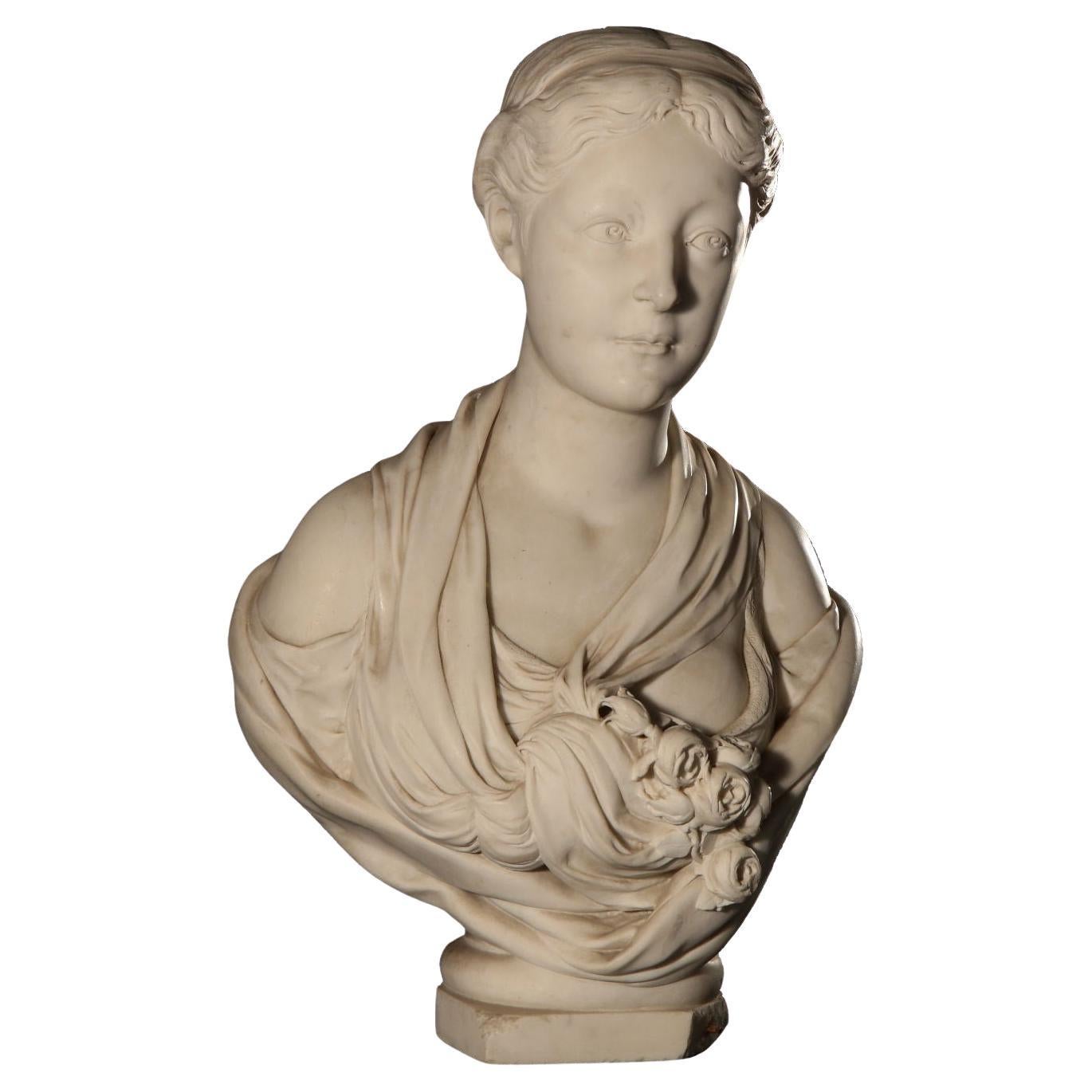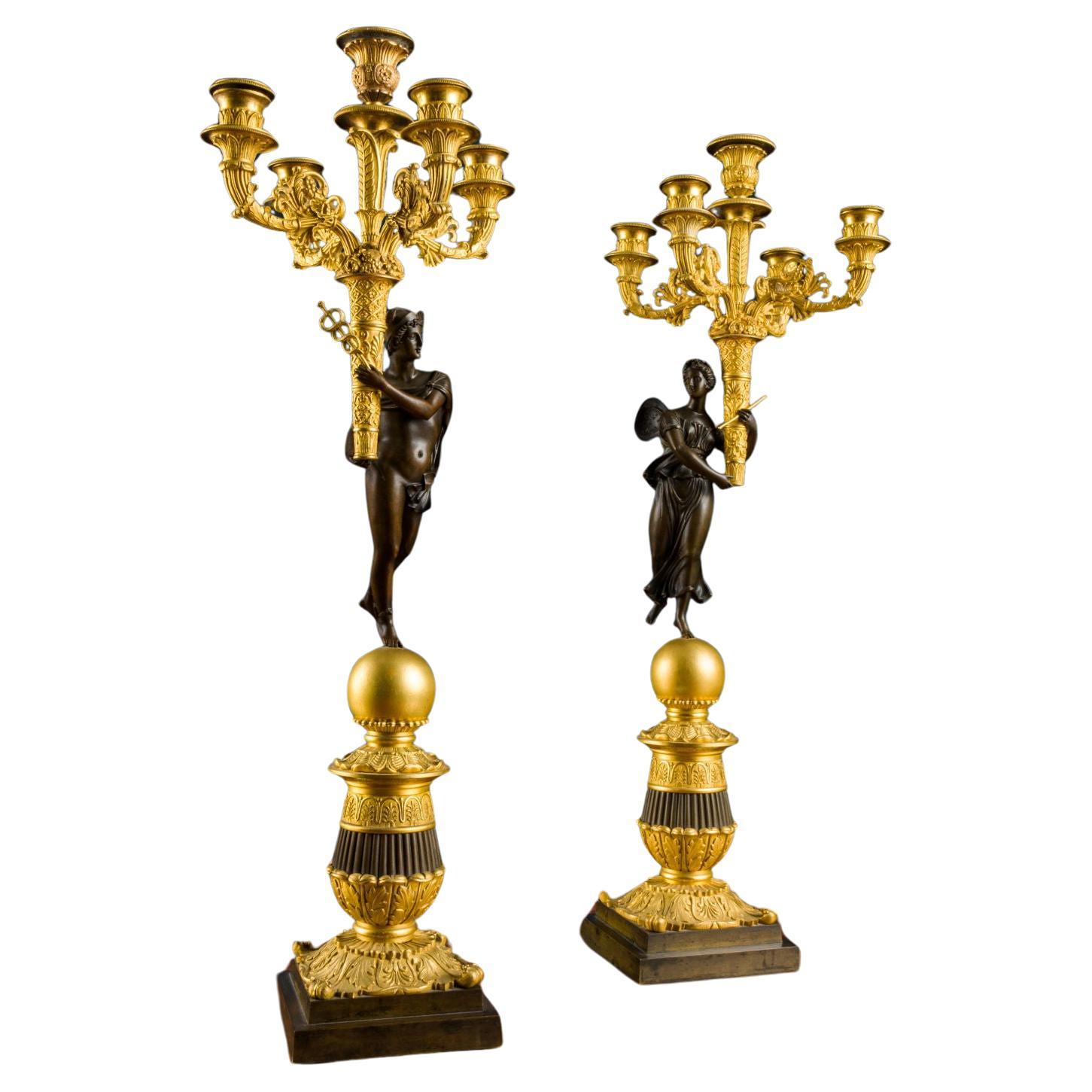Items Similar to Pair of Moors. Venice, Second half of the 19th century
Want more images or videos?
Request additional images or videos from the seller
1 of 12
Pair of Moors. Venice, Second half of the 19th century
About the Item
Pair of torch-holding sculptures depicting two Venetian Moors, one female figure and the other male. In a mirrored position of slight advancement, they hold a tray in one hand while in the other, raised above their heads, a cornucopia with lamp-holding plate. They are dressed in characteristic robes with short skirts, draperies and turbans, decorated with oriental and exotic motifs.
They rest on plinths with an octagonal and concave cross-section, adorned with feral feet and lion heads.
Carved from stone pine wood, they are polychromatically lacquered, with the clothes embroidered by burin and partly gilded.
The depiction of Moors was traditionally rooted in lagoon figurative culture, even before the "Michelangelo of wood" Andrea Brustolon, whose works preserved at the Ca' Rezzonico Museum should undoubtedly be remembered, such as the armchairs of the Fornimento Venier, where Moors serve as the supporting structure of the legs and armrests, or the portavasi with a nude, chained Moretto.
Our pair of sculptures belongs to that production that spread in the second half of the nineteenth century, in the context of revivals of stylistic currents of the past and especially pertinent with what was called Neo-Baroque. In fact, the figures are characterized by pastille workmanship for the texture of the fabrics, a typical mode of execution of the period, as well as by an exotic and oriental flavor in the decorations of the garments, clearly a choice of taste that is an expression of eclecticism, dictated by the heterogeneous figurative influences that are recorded in the late 19th century. A number of other specimens are known with which interesting comparisons are possible, such as the pair of blackberry holders in the Museo d'Arti Applicate del Castello Sforzesco. As reported in the catalog entry, similar figures can be found in the Sarfatti company's mail order catalog, published in 1887. However, this was not the only entity that specialized in wood carving in the neo-Baroque taste: in fact, the workshops of Valentino Besarel (1829-1902), Vincenzo Cadorin (1854-1925), Marco del Tedesco (active in 1887) and Francesco Taso (active in 1878) are also known in these years.
- Dimensions:Height: 87.8 in (223 cm)Width: 24.02 in (61 cm)Depth: 23.63 in (60 cm)
- Sold As:Set of 2
- Style:Baroque Revival (Of the Period)
- Materials and Techniques:
- Place of Origin:
- Period:
- Date of Manufacture:1800s
- Condition:Wear consistent with age and use.
- Seller Location:Milano, IT
- Reference Number:1stDibs: LU1721239133192
About the Seller
4.9
Gold Seller
These expertly vetted sellers are highly rated and consistently exceed customer expectations.
Established in 2015
1stDibs seller since 2015
357 sales on 1stDibs
Typical response time: 1 hour
- ShippingRetrieving quote...Ships From: Milan, Italy
- Return PolicyA return for this item may be initiated within 10 days of delivery.
More From This SellerView All
- Spring marble bust, first half of the 19th centuryBy Non-Standard Furniture and LightingLocated in Milano, ITFemale bust of maiden with bouquet of roses ( Spring). The maiden is portrayed with a slight smile and a deep, attentive gaze, combed with a low chignon and hair lightly held back by...Category
Antique Mid-19th Century Italian Other Busts
MaterialsMarble
- Pair of Candelabra Paris second quarter of the 19th centuryBy Non-Standard Furniture and LightingLocated in Milano, ITPair of partially gilded and burnished bronze candelabra. Stepped base from which departs the turned and chiseled body with leaf and antemium motifs, at the top of which is placed a ...Category
Antique 1850s French Restauration Candlesticks
MaterialsBronze
- Pair of sideboards Lucchese manufacture second decade of the 19th centuryBy Non-Standard Furniture and LightingLocated in Milano, ITPair of sideboards panelled in mahogany feather, resting on feet of which the front ones with a circular plinth, supporting uprights in the form of a lictor's fasces, terminating in ...Category
Antique 1820s Italian Restauration Credenzas
MaterialsMarble
- Coin cabinet, Piedmont, second quarter of the 19th centuryBy Non-Standard Furniture and LightingLocated in Milano, ITTwo-body cabinet completely veneered in mahogany feather; it has both in the narrower upper part and in the lower part two doors surmounted by a drawer and framed by a pair of uprigh...Category
Antique 19th Century Other Sideboards
MaterialsMahogany
- Neo-Renaissance Mirror, Italy, Second Half of the 19th CenturyLocated in Milano, ITNeo-Renaissance mirror, imitating the painted terracotta of the Florentine Della Robbia workshop. With frame in glazed and glazed terracotta, decorated with festoons of fruit and two...Category
Antique 19th Century Italian Renaissance Wall Mirrors
MaterialsTerracotta
- Chinoiserie-style screen. Italy, second quarter 19th centuryBy Non-Standard Furniture and LightingLocated in Milano, ITFive-panel jointed screen; made of poplar entirely lacquered in black, it is decorated with Chinoise-like painted motifs: dragons, monkeys, birds, and reserves depicting scenes of Ch...Category
Antique 19th Century Italian Other Screens and Room Dividers
MaterialsPoplar
You May Also Like
- Sculpture Scipione Tadolini the Greek Slave Second Half of the, 19th CenturyBy Scipione TadoliniLocated in SAINT-JEAN-CAP-FERRAT, FRScipione Tadolini was a skilled sculptor whose broad talent covered the neoclassic to the romantic movements. His ancestors from a dynasty of Roman sculptors exerted a profound and lasting influence on the artistic production of the Eternal City. The Greek Slave fully demonstrates his masterly talent and serves as a reminder of antique models and the orientalist influences characterising the second half of the 19th century. Scipione Tadolini graduated from the Roman Academy and worked with his father on a series of celebrated portraits and ecclesiastical sculptures for Roman churches including a bust of Cardinal Giuseppe Alberghini for the Gesù (1847) and portraits of various members of the Cini family for the Church of Sant’Andrea della Valle (1844, 1846). Tadolini is also known as the author of a number of large-scale monuments for patrons around the world including an equestrian group of Simon Bolivar for the city of Lima, Peru. One of his best known sculptures is The Greek Slave which appears in his work from the late 1850s forward.The Greek Slave was created in several sizes in two variations: with the figure’s hand either raised to her chest or to her chin. The small number of versions all indicate the sculptor’s careful attention to the human form and passion with exoticism, which can be noticed through the tumbling folds of the present figure's headdress and the finely articulated jewellery...Category
Antique Mid-19th Century Italian Neoclassical Figurative Sculptures
MaterialsMarble
- Rare decorative fruit basket made of wax. Italy, second half of the 19th centuryLocated in Milan, ITA rare decorative fruit basket made of wax. The elegant wicker basket contains an arrangement of colored wax fruit. The branches and leaves are made of wire, paper and colored fabric...Category
Antique 1870s Italian Figurative Sculptures
MaterialsMetal
- Folk Art Wooden Sculpture, USA, Second Half 19th CenturyLocated in Milan, ITFruit wood sculpture, Folk Art, depicting a man standing with his hands in his pockets. United States, second half of the 19th century.Category
Antique Late 19th Century American Figurative Sculptures
MaterialsFruitwood
- Pair of Murderous 19th Century Bronze FawnsLocated in London, GBA pair of murderous 19th century bronze fawns each appears to be dispatching a bird. An unusual dark subject perhaps suited to a gothic interior.Category
Antique 19th Century French Baroque Revival Figurative Sculptures
MaterialsBronze
- Memento Mori chain seal, Saint Petrsburg, Russia, second half of 19th century.Located in Milan, ITChain seal in silver and jet. The seal features a rectangular silver plate with a carved noble coat of arms representing a two-headed eagle. The matrix is crowned by a frame with a w...Category
Antique 1860s Russian Figurative Sculptures
MaterialsSilver
- Joyful Pair of 19th Century Bronze Cherubs 'Putti' DancingLocated in London, GBA joyful pair of 19th century bronze cherubs (putti) dancing and playing cymbals and a tambourine, on marble bases.Category
Antique Late 19th Century European Baroque Revival Figurative Sculptures
MaterialsBronze





